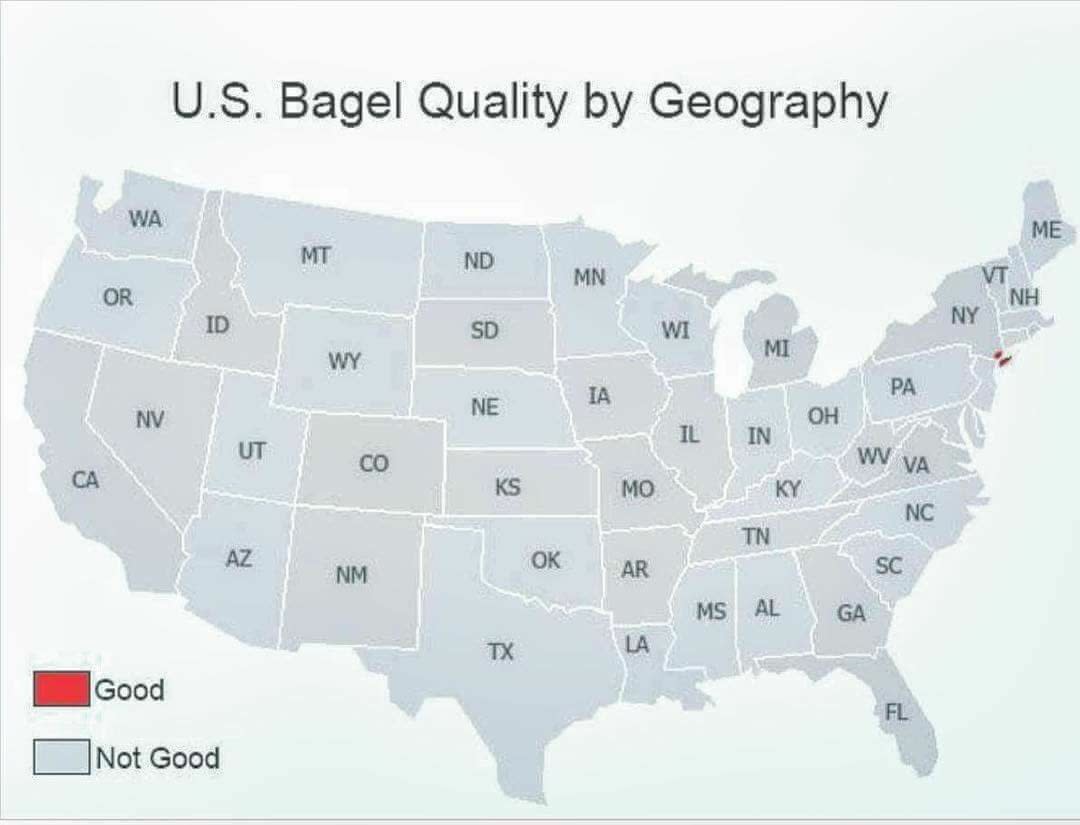One of my deepest disappointments when I moved to western Pennsylvania several years ago was the dearth of bagels. And when I expressed this disappointment to friends, they would usually furrow their brows and say, “I don’t understand. You can get a pack of bagels in any local grocery store in any variety of flavors. What are you talking about?”
No, I mean real bagels. Not a dense and rubbery roll-with-a-hole, packed with preservatives to give it a three-month shelf life and dusted with poppyseed husks to give it the impression of elegance. Pre-sliced, for convenience and for staleness. Or, if you prefer to go one tier higher, you can go to Pittsburgh’s most popular bagel chain and receive a donut with the texture of a hockey puck for an exorbitant price (they forgot not to charge you for the material in the middle). Other nationwide cafes cover up the hole with cinnamon sugar or burnt cheese and market this to unsuspecting customers as a bagel. This is a high-handed violation of everything decent.
A proper bagel is not a breakfast snack. It is an event, an experience, a phenomenon. A proper bagel shop is a greasy little hole in the wall where the first sensory impressions that confront you are the smell of burnt coffee and the sight of poppy and sesame seeds strewn about on the counters and the floor by loyal customers for whom the taste of a fresh bagel outweighs all considerations of propriety and restraint. A proper bagel shop is a place of boisterous greetings, precariously balanced wire racks hanging on the wall behind the counter, and piles of sloppily and lavishly slathered cream cheese. Ideally, a proper bagel shop stays open for lunch and doubles as a Jewish deli. Some of my most vivid childhood memories occurred with a sesame bagel in my hand and a schmear of cream cheese on my lip. When my mother and I would stop at our local bagel place after my weekly piano lesson, the owner would rush out from behind the counter and give us huge hugs. That, dear friends, is what a proper bagel entails.
Where in the grand old U. S. of A., you ask, can I atone for a lifetime of deprivation and experience such a phenomenon for myself? A helpful bagel connosieur, through extensive research, has prepared the following map:

Yes, that’s right, there is only one place in the country where you can find pure bagels that satisfy the above requirements. (Please do not say New Jersey. Nothing inherent in New Jersey, besides its fortuitous proximity to New York, makes it a haven for good bagels. Where they exist, they exist in defiance of it. When placed upright on a flat surface, bagels baked in New Jersey will always roll north and east.)
The point of this bagel-in-cheek post, however, is not a plug for New York tourism. Because, however much New York can take credit for, it cannot take credit for inventing the bagel. The bagel came from somewhere. Where, you might ask?
From Poland.
I quote now from Wikipedia: “A bagel . . . is a bread product originating in the Jewish communities of Poland. . . . Though the origins of bagels are somewhat obscure, it is known that they were widely consumed by Ashkenazi Jews from the 17th century. The first known mention of the bagel, in 1610, was in Jewish community ordinances in Krakow, Poland.”
Besides the atrocity of calling a bagel a “bread product” (tantamount to calling Michelangelo’s David a “person rock”), Wikipedia backs up my newfound conviction that the bagel ought to supplant kielbasi and pierogi as the most famous and most important culinary export from Poland. It also makes the following personal credo sound a little bit less outrageous.
There is something better than a New York bagel, and it is located in Poznań, Poland.
Here is a crummy cell phone picture of this O-shaped marvel. I got it at a place called Bajgle Króla Jana, a recently opened shop a fraction of a mile from where I live. On their website, Bajgle Króla Jana recounts the mysterious history of the bagel (Polish bajgiel) as well as its fateful journey across the Atlantic (perhaps its life-preserver-like shape was the key to a successful voyage).

There is a somber, even tragic component to the story of the bagel. Since the end of World War II, Poland’s Jewish citizenry is all but gone–emigrated, relocated, or in most cases, exterminated. Today’s Poland is 96% Polish, meaning that its once-thriving Jewish communities and cultural artifacts have been almost entirely forgotten. The bagel is a symbol of this national loss. But it is also a symbol of resilience: surviving and gaining new significance in its American exile, just like New York’s Polish Jewish communities, and now returning to bring beauty, diversity, and delight to its homeland.
Today, Bajgle Króla Jana is one of only a few places in Poland producing bagels the old-fashioned way, and their dishes are explicitly inspired by New York. In this case, they have outdone themselves (unlike the mediocre proliferation of “New York style” establishments in other parts of the world). Perhaps the bagel knows its true homeland. In any case, I’m glad that this brief lesson in Polish history and culture comes with such large and immediate dividends to me. If I return to the states with a circular profile and an empty wallet, Bajgle Króla Jana will be to blame.
Another day, I will embark on the delicate philosophical question, which I have up till now avoided, about what the hole of a bagel tastes like. It is something like the sound of one hand clapping . . .
Michael